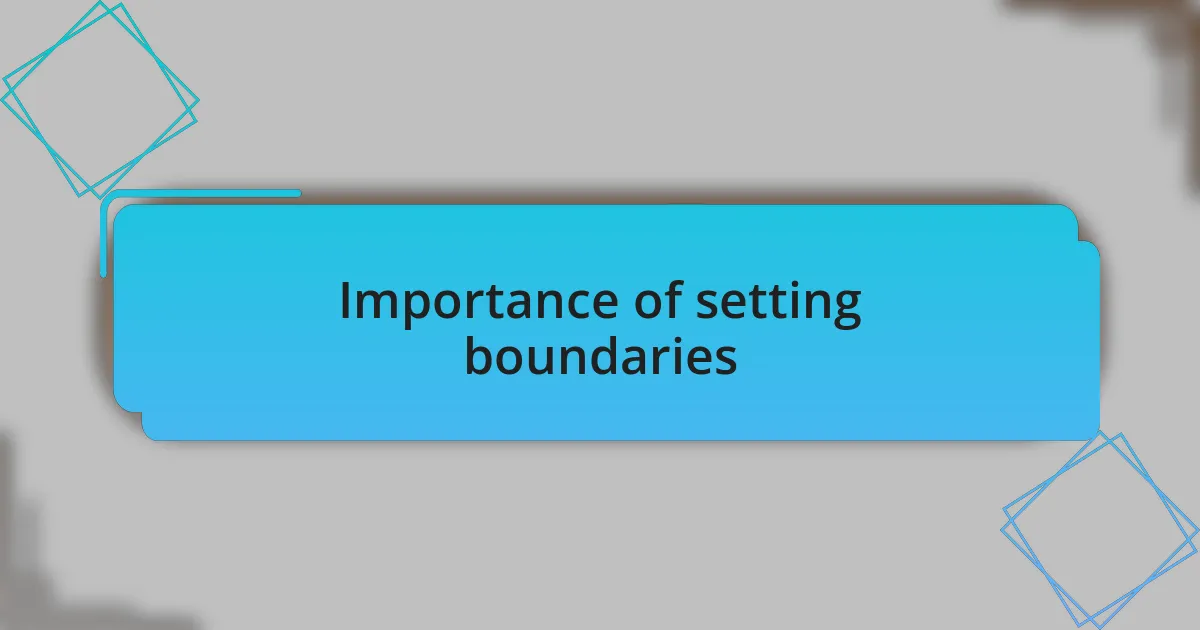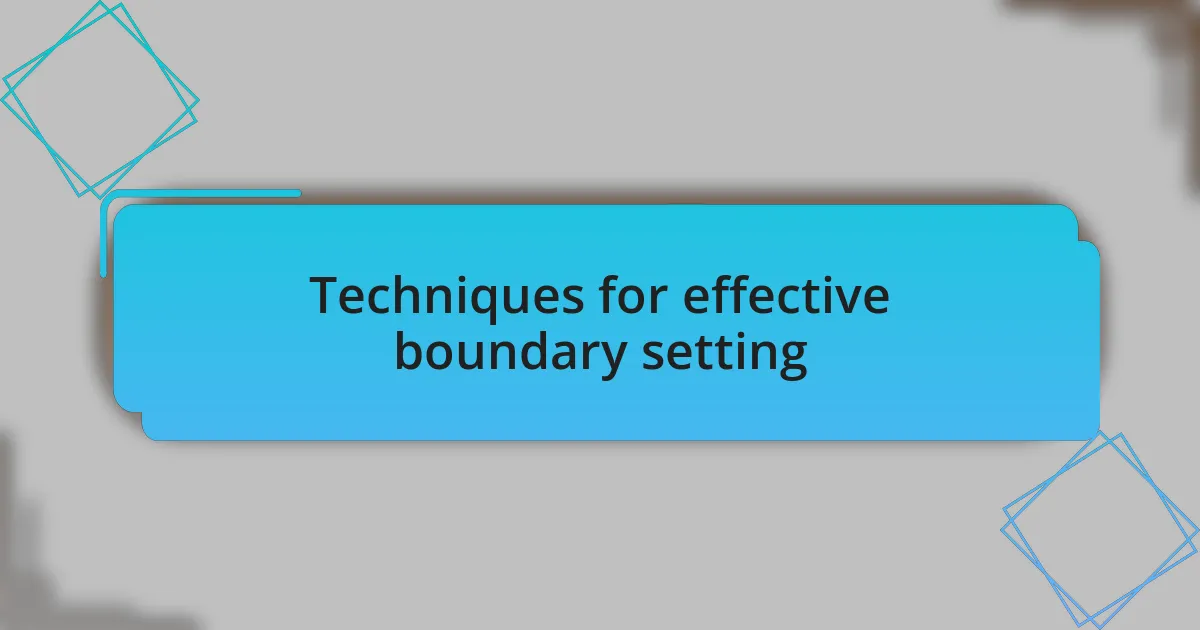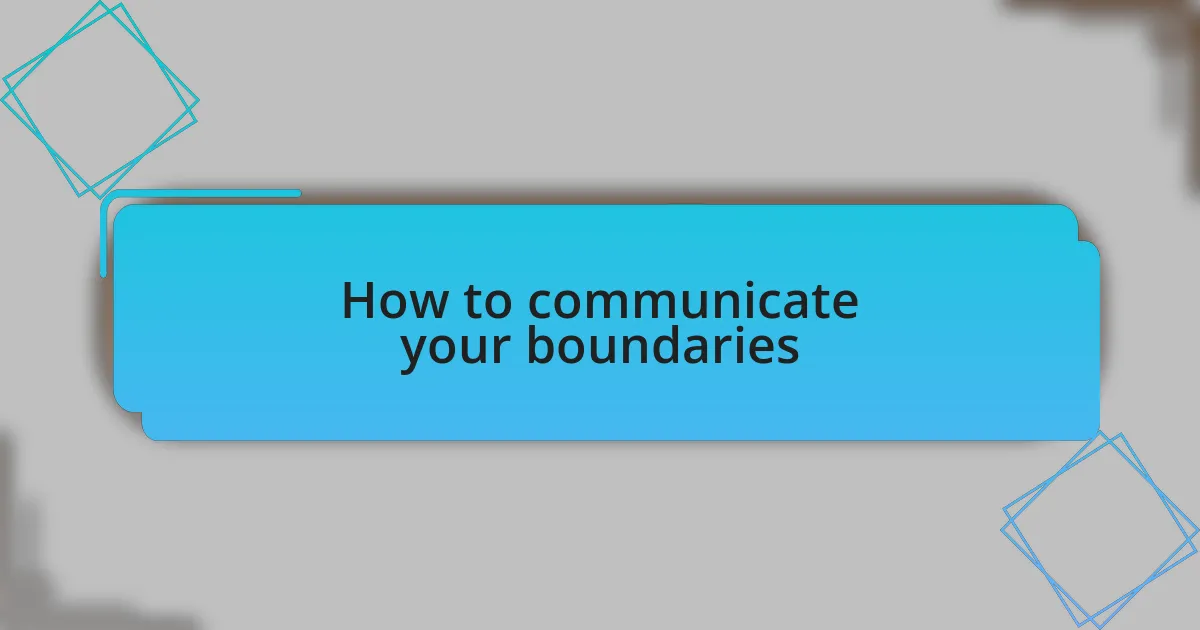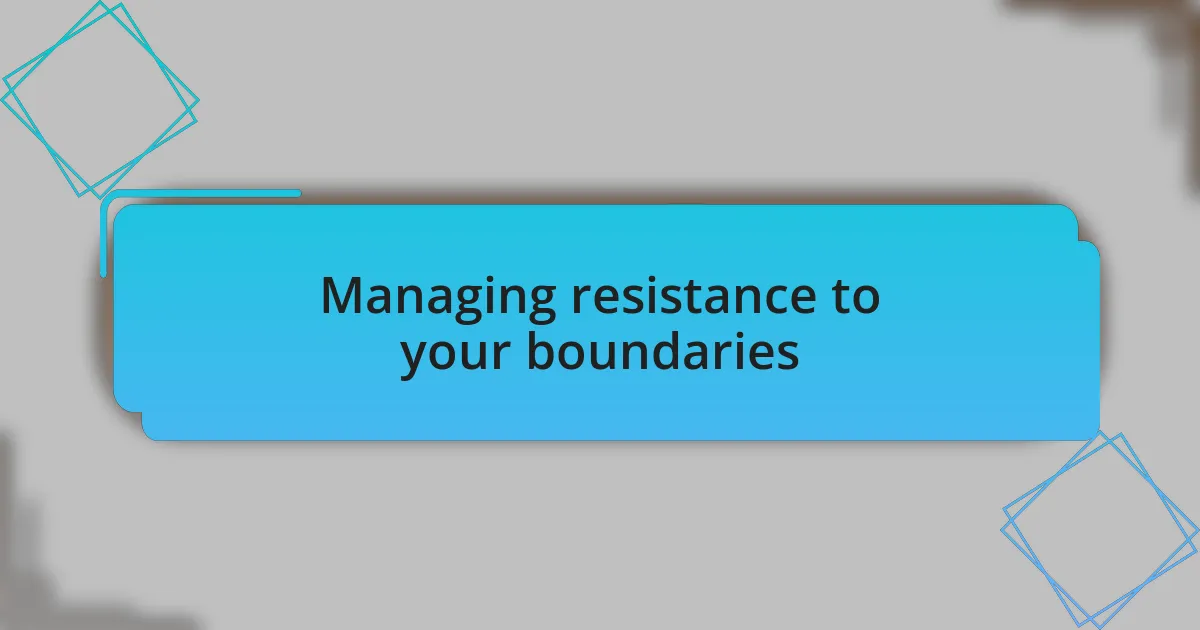Key takeaways:
- Personal boundaries are essential for emotional and physical well-being, enabling healthier relationships with ourselves and others.
- Common challenges in setting boundaries include fear of conflict, guilt over perceived selfishness, and difficulty maintaining consistency.
- Effective communication techniques, such as using “I” statements and nonverbal cues, can enhance boundary setting.
- Navigating resistance to boundaries often requires clear communication and can lead to deeper insights into relationships.

Understanding personal boundaries
Understanding personal boundaries starts with recognizing what they are: the limits we set to protect our emotional and physical well-being. These boundaries can be as simple as needing space when feeling overwhelmed or as complex as deciding who has access to our deepest thoughts. I recall a time when I struggled to assert my need for quiet after a long day; acknowledging that I deserved that space was a turning point in how I viewed my personal needs.
Setting personal boundaries is not about building walls; it’s about creating a safe space for ourselves. I’ve felt the weight of saying “yes” when I actually wanted to say “no,” and that conflict was exhausting. Have you ever found yourself agreeing to things just to please others? It’s a common struggle, but learning to communicate our limits with honesty can be liberating.
When we understand and communicate our boundaries, we foster healthier relationships—not just with others, but with ourselves too. I’ve discovered that being clear about my needs and limits often prompts others to do the same. Isn’t it refreshing to think that setting boundaries can lead to deeper, more authentic interactions?

Importance of setting boundaries
Setting personal boundaries is essential for maintaining our mental and emotional health. I remember a time when I found myself overwhelmed at work because I consistently took on more than I could handle. It was my failure to set clear boundaries that led to burnout. This experience taught me that when we don’t define our limits, we risk losing sight of what truly matters to us.
When we effectively set boundaries, we signal to ourselves and others what we value. For instance, I vividly recall a situation where I had to tell a close friend that I wasn’t available for constant late-night calls. Initially, I was worried about disappointing them, but establishing that boundary allowed me to regain my peace and strengthen our friendship. Have you ever hesitated to assert your needs for fear of hurting someone? It’s a common challenge, but setting boundaries can actually deepen our connections.
Moreover, boundaries empower us to prioritize our needs without guilt. After I made a conscious decision to limit my availability on weekends, I found time to recharge and engage in activities that brought me joy. It was a game changer, showing me that I could honor my own needs while still being there for others. Isn’t it incredible how simply setting a limit can transform our experiences and relationships?

Common challenges in setting boundaries
Setting boundaries comes with its share of challenges, and one of the most significant is the fear of conflict. I recall a time when I wanted to tell my colleague that their constant interruptions were affecting my focus. The thought of disappointing them or even facing a confrontation held me back for days. Have you ever found yourself in a similar situation, weighing the discomfort of an honest conversation against the desire to keep the peace? It’s a tough call.
Another challenge is the internal voice that tells us we’re being selfish for wanting personal space. I remember grappling with this concept when I decided to step back from a family obligation that always drained me. It felt wrong at first, like I was letting them down. But as I learned to embrace the idea that my well-being matters too, I slowly began to see the importance of protecting my own energy. Isn’t it interesting how we often prioritize others, even when it comes at our own expense?
Lastly, there’s the difficulty of consistency in maintaining boundaries. I struggled with this when I attempted to make early evening a no-work zone for myself. My intention was clear, but distractions kept cropping up, and I found it hard to say no to last-minute tasks. This inconsistency made me question my commitment to my own boundaries. Have you faced similar temptations to compromise your needs? Understanding that it takes practice and sometimes a conscious effort to stick to our limits can be enlightening.

Techniques for effective boundary setting
One effective technique I’ve found for setting boundaries is to use clear and assertive communication. When I began expressing my limits with firm yet polite language, I noticed a remarkable shift in how others responded. Have you ever experienced the freedom that comes from stating your needs clearly? It can feel empowering to articulate what you are and aren’t comfortable with.
Another approach I advocate is the visualization of boundaries as a protective shield. I often imagine a soft barrier around myself that allows positive interactions to flow in while keeping negativity at bay. This mental exercise has helped me reinforce my limits, especially when facing pushy colleagues or demanding friends. Have you ever tried visualizing your boundaries? It can be a simple yet powerful way to bolster your resolve.
Lastly, regularly reviewing and adjusting my boundaries proves essential. I recall a period when I thought my no-work evenings were a fixed rule, but as life evolved, so did my needs. I learned to reassess and adapt my boundaries to better fit my circumstances. Isn’t it fascinating how our lives change, requiring us to be flexible in protecting our personal space? By checking in with myself, I stay attuned to what feels right, which enhances my overall well-being.

How to communicate your boundaries
Communicating boundaries effectively is all about clarity and confidence. I remember a specific instance when I had to explain to a friend why I couldn’t take on any additional responsibilities at work. I used “I” statements to express my feelings, saying, “I feel overwhelmed when I have too many tasks on my plate.” This not only helped my friend understand my perspective but also opened the door for a deeper discussion about mutual support.
In practice, I’ve found that nonverbal cues significantly enhance the message. One time, while discussing my boundaries with a family member, I noticed my body language was tense. I made a conscious effort to relax and maintain eye contact. This simple adjustment made me feel more grounded and conveyed my seriousness, ensuring my words resonated. Have you ever noticed how people respond differently based on your posture and demeanor?
Additionally, I like to use real-life examples to illustrate my boundaries. When talking with colleagues about my work hours, I shared a personal story about a previous burnout experience due to overcommitment. This not only clarified my limits but also fostered empathy. After all, how can we expect others to respect our boundaries if they don’t understand the reasons behind them? By being open and sharing our experiences, we invite understanding and respect into our relationships.

Managing resistance to your boundaries
Navigating resistance to your boundaries can be a delicate process. I remember a time when I told a colleague I couldn’t participate in weekend meetings. Initially, he pressured me, insisting it was essential. Rather than becoming defensive, I calmly reiterated my commitment to work-life balance, reminding him that maintaining my boundaries ultimately enhances my productivity during work hours. How often do we overlook the value of our time simply to appease others?
I’ve also learned that people might resist our boundaries because they fear change; they’re often accustomed to our previous compliance. This was evident when I decided to stop agreeing to last-minute changes to my schedule. It took some time for my friends to adapt, but I communicated consistently, reassuring them that my boundaries didn’t mean I’d be unavailable – only that I was prioritizing my time better. It’s fascinating how clarity can shift perspectives, isn’t it?
Sometimes, embracing resistance can provide deeper insights into our relationships. For instance, when a family member pushed back against my limits regarding phone calls during late hours, it revealed their insecurity about feeling neglected. This opened up a heartfelt conversation where we discussed expectations, allowing us both to redefine our relationship dynamics. Isn’t it intriguing how resistance can lead to a more profound understanding if we engage with it constructively?